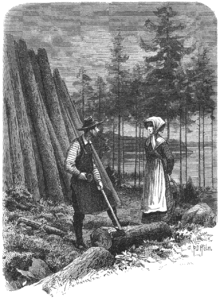
The Skogsrå (Swedish: skogsrået [ˈskʊ̂ksˌroːɛt] ; lit. 'the Forest Rå'), Skogsfrun ('the Mistress of the Forest'), Skogssnuvan, Skogsnymfen ('the Forest Nymph'), Råndan ('the Rå') or Huldran, is a mythical female creature (or rå) of the forest in Swedish folklore.[1][2][3]
It appears in the form of a small, beautiful woman with a seemingly friendly temperament. She appears like a woman from the front but seen from behind she often has a tail and a hollow back or skin like tree bark.
Those who are enticed into following her into the forest are never seen again. It was said that any human man who had intercourse with the Skogsrå became an introvert, as his soul had remained with her. If the seduced man is a hunter, he may be rewarded with good luck in the hunt, but should he be unfaithful to the Skogsrå, he will be punished with numerous accidents. He may put an end to a stormy night caused by her vengeance by firing a shot against her.[4] Late folklore in Nyland, Finland describes silver bullets as effective means of killing a skogsrå.[5]
YouTube Encyclopedic
-
1/2Views:11 4481 380
-
The Huldra or Skogsrå: Scandinavian Huldrefolk and Haugfolk Explained
-
Scandinavian Folklore - Skogsrå (Mistress of the Forest)
Transcription
Popular culture
- The character Esmeralda (played by Happy Jankell) in SVT's thriller television series Jordskott is called "what traditionally would be described as a skogsrå". She is shown having a hollowed back and the ability to drive people to suicide.[citation needed]
- In 1877, Swedish poet Viktor Rydberg published a poem titled "Skogsrået."[6]
- Between 1894 and 1895, Finnish composer Jean Sibelius composed a tone poem based on Rydberg's poem, bearing the same title.
- French Nordic folk group Skáld adapted Rydberg's poem for their 2022 single "Då Månen Sken."[7][6]
- In the game Unforgiving: A Northern Hymn, a skogsrå roams the forest where she bites her victims and turns them into trees, eventually Linn encounters the Forrest spirit and gets bitten, however she manages to be free of the infection with the help of the Näcken.
- In the video game Bramble: The Mountain King, a skogsrå, disguised as a black haired woman, lures many of a village's men into the forest. This leads to a witch hunt executing every woman in the village with dark hair.
- Skogsra appears as a demon in multiple games of the Shin Megami Tensei series.
References
- ^ Granberg, Gunnar (1935). Skogsrået i yngre nordisk folktradition. Skrifter / utg. av Kungl. Gustav Adolfs akademien för folklivsforskning, 99-0440828-9 ; 3 (in Swedish). Uppsala: Lundequistska bokh. SELIBR 321677.
- ^ Hultkrantz, Åke, ed. (1961). The supernatural owners of nature: Nordic symposion on the religious conceptions of ruling spirits (genii loci, genii speciei) and allied concepts. Stockholm studies in comparative religion, 0562-1070 ; 1. Stockholm: Almqvist & Wiksell. SELIBR 541848.
- ^ Häll, Mikael (2013). Skogsrået, näcken och djävulen: erotiska naturväsen och demonisk sexualitet i 1600- och 1700-talens Sverige (in Swedish). Stockholm: Malört. ISBN 978-91-978751-2-7. SELIBR 13887591.
- ^ Rietz, Ernst (1962) [1862–1867]. Svenskt dialektlexikon (in Swedish). Malmö [Lund]: Gleerups. p. 59.
- ^ Finlands svenska folkdiktning II 3:2, s. 330
- ^ a b "Litteraturbanken | Svenska klassiker som e-bok och epub". litteraturbanken.se. Retrieved 2022-09-28.
- ^ SKÁLD - Då Månen Sken (Visualizer), retrieved 2022-12-16

